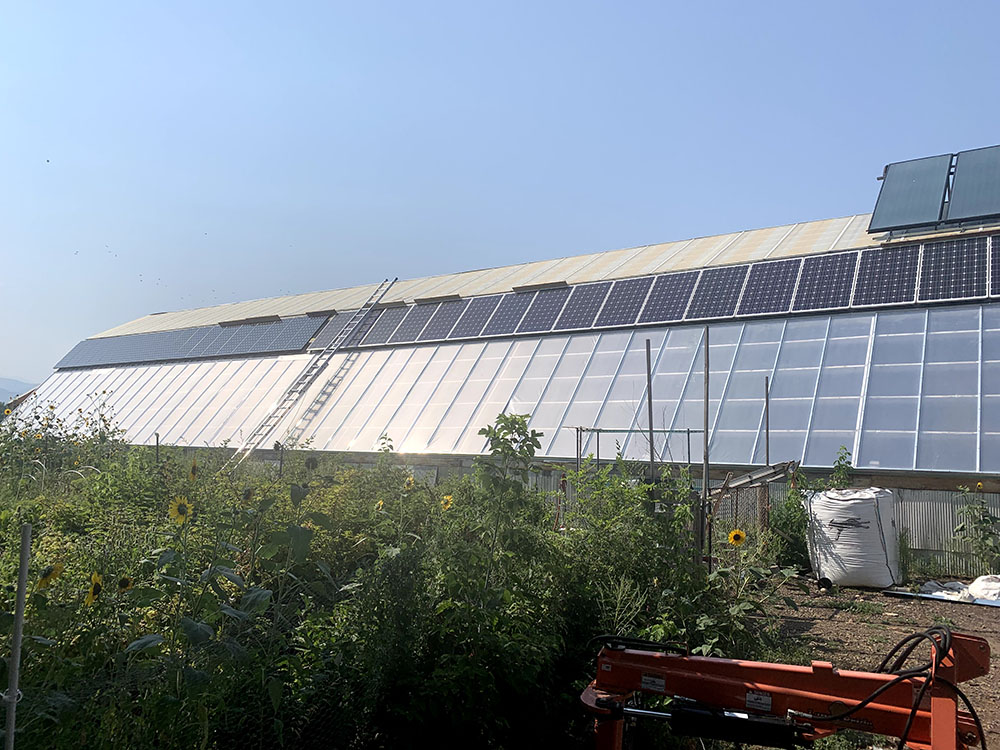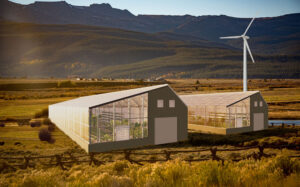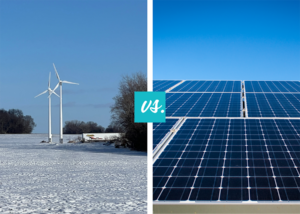What is ETFE Material?
Widely used in Japan for decades but with little use in the United States, Ethelyne Tetrafluoroethelyne (ETFE) is a fluoropolymer that is increasingly being used as a cladding material in the construction of greenhouses due to its unique properties. At Ceres, we are excited to offer this new glazing material to clients looking to retrofit their current greenhouse and clients interested in a full scale Ceres energy efficient ETFE greenhouse. For those who are unfamiliar with ETFE film, let’s go over the benefits of using this material for your greenhouse project.
Why use ETFE greenhouse film?
ETFE is a standout choice for greenhouse glazing due to its excellent light transmission capabilities, allowing over 95% of light, including the full UV spectrum, to penetrate your greenhouse. This selective transmission is key; it not only admits the majority of UV light but also optimizes the entry of Photosynthetically Active Radiation (PAR) that plants require for effective photosynthesis. Even on days with low natural light, ETFE ensures that your plants are not starved of the critical wavelengths needed for their growth.
The presence of UV light, especially UV-A, is crucial for plant health and vigor. It encourages plants to grow faster and healthier while enhancing the flavor and nutritional value of the produce. Plants in a natural UV environment tend to produce a higher quantity of protective compounds such as beta carotene, anthocyanin, and glycosides. These compounds are essential for improving the color, flavor, and nutritional content of various plant species. Additionally, the UV spectrum light helps to control pest populations and reduces the prevalence of molds, funguses, and certain plant diseases in the greenhouse environment. This leads to healthier plant growth and potentially higher yields, making ETFE an invaluable material for modern greenhouse designs.
After replacing their polycarbonate glazing with ETFE film, our friends at Golden Hoof greenhouse (pictured below) have experienced a decrease in pest pressure, specifically slugs and aphids, since installing their ETFE film. We believe that this may have something to do with an increase in UV spectrum light in the greenhouse because researchers have found that higher levels of glycosides and other protective compounds deter pests in some plant species.

Another benefit of ETFE’s increased light transmission is its remarkable energy efficiency. The high degree of transparency significantly reduces the need for artificial lighting, leading to considerable energy savings and a lower carbon footprint.
Furthermore, when ETFE is installed in multiple layers, its superior thermal properties come into play, effectively retaining heat during the colder seasons and minimizing heat gain in the warmer seasons. This feature helps in lowering heating and cooling costs and reducing overall energy consumption.
Beyond cost savings, ETFE glazing can also lead to increased crop yield and revenue for greenhouse owners. By optimizing light transmission and creating an ideal growing environment, ETFE enables growers to produce higher-quality crops in larger quantities. This translates to higher market value and increased profitability for greenhouse operations, further enhancing the return on investment.
ETFE is lightweight and strong. Only 1/100th the weight of glass, ETFE allows for wider truss spacing and, therefore, less shading in your greenhouse. Wider truss spacing also leads to cost savings in the design and construction of the greenhouse. And yet, ETFE is remarkably strong for how lightweight it is. ETFE can elongate up to 400% without breaking, making it a great option for locations that experience a lot of hail, high winds, or are prone to earthquakes. We have different thicknesses of ETFE we can offer (60 um – 300 um) based on site specific weather challenges.
ETFE stands out for its longevity and minimal maintenance needs compared to traditional glazing materials like polycarbonate. A typical polyethylene greenhouse requires re-sheeting every 3-5 years due to a decline in light transmission. In contrast, ETFE film maintains its light transmission capacity remarkably well, losing only about 5% over 20 years. There are instances of ETFE greenhouses in Japan that continue to function effectively even after 30 years. This durability is partly due to ETFE’s resistance to UV radiation and chemical damage, which helps it maintain clarity and structural integrity for decades.
Moreover, ETFE is self-cleaning thanks to its nonstick surface. This property ensures that snow and debris like dust or pollen, which could otherwise lower light transmission levels, slide off more easily than with other materials. Additionally, its resistance to common issues like drip marks further reduces the need for frequent cleaning and maintenance. These features result in significantly lower operational costs over the lifespan of the greenhouse. By choosing ETFE, greenhouse owners can enjoy not only enhanced growing conditions but also substantial savings in time and resources, enhancing overall efficiency and productivity.

The photo above is a project done by Vector Foiltec, and it is an ETFE enclosure over a Mangrove Hall at the Royal Burgers Zoo in the Netherlands. The first structure (above) was built in 1982 and functioned sufficiently until it was replaced in 2017 (below). The construction of the newer enclosure over 30 years later speaks to the durability and strong positive attributes of the ETFE film.

ETFE can be installed in one, two, or three layer configurations. The outer layer is thick (100-300 microns) to protect the greenhouse from the elements and is completely clear to allow up to 95% light transmission. The inner layer is able to be much thinner (60 microns). Both layers combined create a diffuse effect which eliminates shadows and scatters the light as it enters the greenhouse, allowing the light to penetrate the plant canopy more effectively. A bubble of air sits between the two layers of ETFE, which gives it an R-value of about 1.8 ft2·°F·h/BTU (US) or 0.32 m2·K/W (SI). ETFE film is available in clear or diffuse.

ETFE is flexible and versatile
ETFE is a highly flexible glazing material that can be shaped and formed into complex shapes and geometries. This allows for greater design flexibility in the construction of greenhouses, which can lead to more efficient use of space and improved aesthetics.
Besides greenhouses, ETFE film has been used to cover many types of structures including sports stadiums, hospitals, shopping centers etc., and is used in many other types of architectural projects due to its aesthetic appeal.
Ceres’ Custom Solutions and Consultation:
At Ceres Greenhouse Solutions, we understand the importance of maximizing operational savings while ensuring optimal performance in your greenhouse. That’s why we proudly offer custom ETFE solutions tailored to meet the specific needs and goals of each client. Our team of experts provides personalized consultation and support throughout the entire process, ensuring that your investment in ETFE glazing not only enhances plant growth and performance but also brings about long-term operational savings.
ETFE glazing is a superior choice for any greenhouse, offering significant advantages such as reduced energy consumption, lower maintenance costs, and increased crop yield and revenue. Its durability, self-cleaning properties, and excellent light transmission capabilities allow greenhouse owners to optimize their operations and achieve sustainable success. If you’re interested in learning more about how ETFE can benefit your greenhouse, contact Ceres Greenhouse Solutions today. Our team is ready to help you unlock the full potential of ETFE and ensure you achieve maximum efficiency and cost-effectiveness.
Watch our short introductory video to ETFE on our Youtube Channel!
For more information:
http://www.international-agrophysics.org/
https://uvhero.com/do-plants-need-uv-light/
https://www.uv4plants.org/wp-content/uploads/2014/10/UV-web-opt.pdf
https://www.maximumyield.com/tanning-your-plants-the-curious-effects-of-uva-and-uvb/2/2990
https://www.agcchem.com/blog/8-ways-growers-yield-better-roi-using-etfe-greenhouse-film/
https://www.greenhousegrower.com/technology/customizing-crop-foliage-color-with-leds-red-leaf-lettuce/
http://ursalighting.com/effect-uv-light-plants/https://journals.plos.org/plosone/article?id=10.1371/journal.pone.0188522











